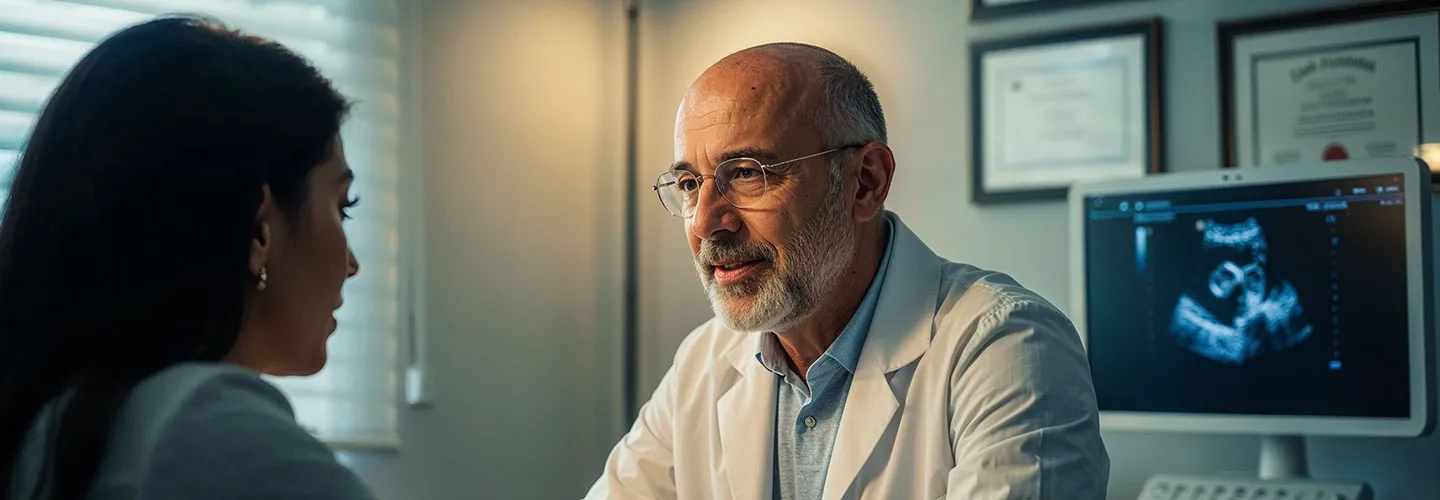From an 11-Year Wait to a 10-Day Test? Endometriosis Diagnosis 2025.

- The “Endo” Problem: Why Was It So Hard to Diagnose?
- The Big Shift: Why Laparoscopy is NO LONGER the “Gold Standard”
- Level Up Your Ultrasound: The “Sliding Signs” and “Soft Markers” We Look For
- The Super-Mapper: When Do We Need an MRI?
- The 2025 Game-Changer: A Saliva Test for Endometriosis?
- Dr. Aksoy’s Quick-Fire FAQ: Busting “Endo” Myths
- Conclusion: A New Era of Believing Patients
Hello! I’m Dr. Senai Aksoy. For years, I’ve sat across from women who are exhausted, in pain, and utterly frustrated. They come to me with a story I know all too well: “Doctor, I have debilitating period pain, pain during sex, and bloating that makes me look 6 months pregnant… but I’ve been told for years that it’s ‘just a bad period’ or ‘all in my head.’”
If this sounds familiar, you are not alone. And you are not “crazy.”
The single most frustrating statistic in all of women’s health might be this: the average time to get an endometriosis diagnosis is between seven and eleven years. A decade of pain. A decade of being dismissed. A decade of the disease potentially getting worse.
Why? Because for the longest time, the “official” way to diagnose it was with invasive surgery.
Well, I’m thrilled to tell you that the rules have finally changed. As of 2025, the game is completely different. The old “gold standard” is gone, and new, non-invasive technology is here.
So grab a cup of tea, and let’s talk about how we actually diagnose endometriosis in 2025—and how we can finally end that ridiculous 11-year wait.
The “Endo” Problem: Why Was It So Hard to Diagnose?
First, a 10-second refresher: endometriosis is a chronic inflammatory condition where tissue similar to the lining of your uterus (the endometrium) decides to grow outside of it—on your ovaries, fallopian tubes, bowel, and bladder. This misplaced tissue acts like it’s still in the uterus, bleeding and swelling every month, but with nowhere to go. This causes inflammation, scar tissue (adhesions), and, you guessed it, a whole lot of pain.
The “Catch-22” of diagnosis used to be laparoscopy. This is a keyhole surgery where a surgeon makes a small cut in your belly button, inserts a camera, and literally looks for the endo lesions.
Doctors were (rightfully) hesitant to send patients for surgery without strong evidence… but the only way to get “definitive” evidence was surgery. The result? Years of “let’s wait and see,” “try this painkiller,” or “it’s probably just IBS”.
The Big Shift: Why Laparoscopy is NO LONGER the “Gold Standard”
This is the most important update, so I’ll say it again for the people in the back: Laparoscopy is no longer the gold standard for diagnosing endometriosis.
The change came from the highest level. The ESHRE (European Society of Human Reproduction and Embryology), one of the world’s most important guideline-setters, released a major update. They officially demoted laparoscopy, stating that it should not be used as the first step for diagnosis anymore. ESHRE Guideline
So, what is the new #1? It’s something much simpler, faster, and non-invasive.
The new first-line recommendation is expert imaging—specifically, a high-quality transvaginal ultrasound (TVS) or, in some cases, an MRI.
Level Up Your Ultrasound: The “Sliding Signs” and “Soft Markers” We Look For
Now, I’m not talking about the standard, 5-minute ultrasound you get to check on your follicles. This is an “advanced” or “expert” ultrasound, performed by someone who knows exactly what to look for.
How do we do this? With some very cool (and simple) detective work. A group of international experts (called the IDEA Consensus Group) agreed on a few “tells” that scream “endometriosis.”
We’re looking for two main things:
1. “Soft Markers”
These are the subtle clues that endo leaves behind:
Ovarian Mobility: Are your ovaries “stuck”? I use the ultrasound probe to gently nudge your ovaries. If they slide around freely, that’s great! If they’re “stuck” to your uterus or pelvic wall, it’s a huge sign that adhesions (scar tissue) have “glued” them down. This is critical to know, especially if we’re planning IVF ovarian stimulation.
Site-Specific Tenderness: This is the “Ouch, THAT’S the spot!” test. As I’m scanning, I’ll gently press on specific areas like your uterosacral ligaments. If you jump and say, “Yes, that’s my pain,” it’s a very strong indicator that there are active, inflamed endo lesions right there.
2. The “Uterine Sliding Sign”
This one is my favorite—it’s simple, but it tells us so much. We check to see if your uterus “slides” freely over the rectum (bowel) behind it.
If it doesn’t slide, it means the Pouch of Douglas (the space between the uterus and bowel) is “obliterated” or stuck together. This is a tell-tale sign of deep endometriosis and is vital information for a surgeon, as it tells them they’ll likely be dealing with the bowel.
The Super-Mapper: When Do We Need an MRI?
If the ultrasound is the “detective,” the MRI is the “GPS.”
We use an MRI (Magnetic Resonance Imaging) to “map” the disease, especially when we suspect “Deep Infiltrating Endometriosis” (DIE), where the tissue has grown more than 5mm deep into organs.
Think of it as a super-powered GPS that’s essential for surgical planning. It uses special settings:
One (called T1-weighted) is brilliant at spotting blood—that’s how we see “chocolate cysts” (endometriomas) on the ovaries.
Another (T2-weighted) is an expert at finding fibrosis, or scar tissue, which is the “deep” part of deep endo.
An MRI map allows us to build a multidisciplinary team (like a bowel surgeon or urologist) before your surgery. (Bonus: It also helps us spot other potential culprits for your symptoms, like uterine fibroids, which can often co-exist).
The 2025 Game-Changer: A Saliva Test for Endometriosis?
Okay, this is the one that sounds like science fiction, but it’s real.
Yes, you read that right. A saliva test.
A French company has developed a groundbreaking test called the Ziwig Endotest®. It’s non-invasive, simple, and poised to completely revolutionize the diagnostic pathway.
How on earth does it work?
The Science (Simple Version): Your body uses tiny genetic messengers called microRNAs (miRNAs) to run all sorts of processes. It turns out that your saliva is full of them.
The Pattern: In women with endometriosis, the pattern—or “signature”—of these miRNAs is significantly different from women without it.
The “Brain”: The problem is, this pattern is incredibly complex. We’re talking thousands of data points that need to be analyzed. This is where Artificial Intelligence (AI) comes in. The AI “brain” was trained to instantly recognize the specific miRNA signature of endometriosis.
The Result: A diagnostic test with a CE mark (meaning it’s approved for use in Europe) that has stunningly high accuracy in clinical trials:
- Sensitivity: >97% (Its ability to correctly identify someone with the disease)
- Specificity: >93% (Its ability to correctly identify someone without the disease)
This test can, quite literally, reduce the diagnostic delay from 7-11 years to a matter of days. It’s indicated for women aged 18-43.
A crucial note from me (Dr. Aksoy)
This test gives us a “Yes” or “No” answer to “Do I have endometriosis?” It does not tell us “Where is it?” or “How severe is it?” After a “Yes” from the saliva test, we still need our expert imaging (like the ultrasound or MRI) to “map” the disease and create a treatment plan.
Dr. Aksoy’s Quick-Fire FAQ: Busting “Endo” Myths
With all this new info, let’s clear up a few of the most common questions I get in my Istanbul clinic.
Q: Does my “stage” (I-IV) equal my pain level?
A: Nope! This is the biggest myth. The ASRM staging system is a surgical classification—it’s about what the surgeon sees (size, location, depth), not what you feel. You can have “minimal” Stage I endo and be in agony, or “severe” Stage IV and have fewer (or different) symptoms.
Q: Does endometriosis mean I can’t get pregnant?
A: This is a huge, valid fear. Endometriosis is a leading cause of infertility—in fact, 30-50% of women with infertility are found to have it. It can cause inflammation, create scar tissue that blocks the fallopian tubes, or even affect egg quality.
However, a diagnosis does NOT mean it’s impossible to get pregnant. Many patients go on to have healthy babies. For those who struggle, this is where we come in. Treatments like IVF (In Vitro Fertilization) are extremely effective at bypassing the barriers that endo creates.
Q: Will menopause cure my endometriosis?
A: Mostly, yes, but not always. Endometriosis is an estrogen-fueled disease. When menopause arrives, the “fuel” (estrogen) from your ovaries is cut off, and the lesions tend to shrink, causing symptoms to fade. However, it can remain active in some cases, especially if you take Hormone Replacement Therapy (HRT).
Q: My doctor said I might have PCOS. Is that the same thing?
A: Great question. They are two completely different beasts, though they can both (rudely) affect your periods and fertility. Think of it this way: PCOS is primarily a hormonal and metabolic issue (often with many small follicles, or “cysts,” inside the ovary). Endometriosis is an inflammatory and tissue-location issue (with tissue outside the uterus).
Conclusion: A New Era of Believing Patients
The biggest update for 2025 isn’t just a machine or a test. It’s a change in philosophy.
For the first time, our official guidelines and technology are catching up to what women have been screaming for decades. The journey from “it’s just a bad period” to a fast, non-invasive, validated diagnosis is finally here.
Your pain is real. It has a name. And now, we have better, faster, and kinder ways to find it.
If you’ve been on that 11-year journey and are tired of waiting, please, stop suffering in silence. Let’s talk. We can build a modern plan for you, from a smart diagnosis to a treatment plan that fits your life—whether that’s pain management or fertility planning, all the way to a successful embryo transfer.
My team in Istanbul is here to listen. And most importantly, we’re here to believe you.
Date of Publication: October 26, 2025
Legal Disclaimer: This blog post is for informational purposes only and does not constitute medical advice. The information provided is not intended to replace a consultation with a qualified medical professional. Always seek the advice of your physician or other qualified health provider with any questions you may have regarding a medical condition. Do not disregard professional medical advice or delay in seeking it because of something you have read on this website.
The content has been created by Dr. Senai Aksoy and medically approved.

